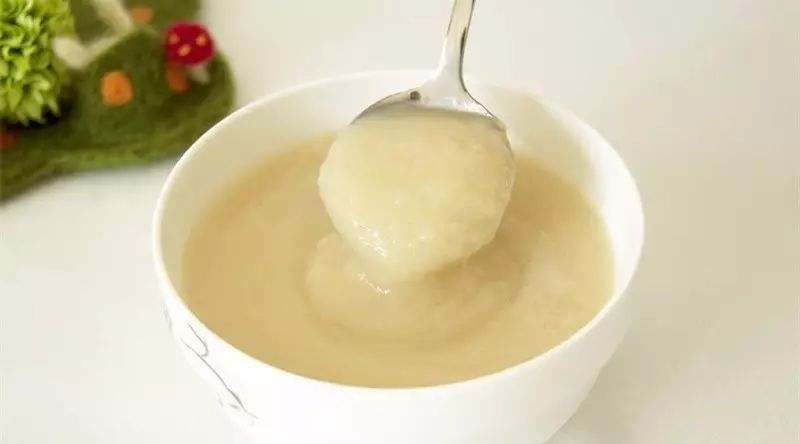Adding supplementary foods will mean a big step forward in the baby’s life.
Mothers always have all kinds of doubts about the addition of supplementary foods to their babies:
How old is the baby? Four months or six months?
Can babies eat meat and fish when they are in what?
How many meals does the baby eat best every day?
Today’s < < Notes on Supplementary Foods > >, nutritionist and teacher Li Liangli, the hot mom of Erbao, brought us [6 ~ 24 months’ guide to adding supplementary foods].
Detailed answers are given on when, how and how much babies of different ages will eat, and a reference < < feeding schedule > > is also given. Come and have a look!
When did the baby start to add supplementary foods in what?

It is recognized by all countries that the time point when the baby starts to eat supplementary foods is 6 months old, but this figure can certainly fluctuate.
Our suggestion is: at least 6 months, not earlier than 4 months.
Mom and Dad can pay attention to observe, if the baby has the following performance, you can consider adding supplementary food:
- If you are interested in adult food, you can maintain a sitting posture. If you put something solid in your mouth, the sticking tongue reflex of your small tongue disappears and you can swallow food.
However, it should not be added too early in a hurry-if it was 4 months ago, the baby’s digestive system was immature and prone to dyspepsia; Moreover, adding supplementary foods so early may increase the risk of food allergy.
Too late also has hidden dangers-at the 3rd and 4th months, the baby will consume almost the same amount of iron brought by his mother. If he starts eating supplementary foods too late, iron deficiency anemia may occur. Even if iron is supplemented in time, supplementary food is not eaten, and supplementary food is given to the baby later than 8 months, the phenomenon that the baby rejects solid food may occur in the future.
How should supplementary foods be added?

Before telling you how babies of all ages should eat supplementary foods, I would like to tell you the following principles for adding supplementary foods.
1. From one to many
From the very beginning, it should be remembered that only one kind of new food will be added, and the same kind of food will be tried for several more days in a row. When the baby gets used to it, new ones will be added.
This is to judge whether the baby can accept it and whether it will be allergic, such as rash, diarrhea, vomiting and other reactions.
If there is a reaction, symptoms will usually appear within 6 hours. If there are symptoms, this kind of food will be stopped first and added after 3 or 4 months, and the baby may not be allergic.
2. From thin to thick, from fine to coarse
The same kind of food should be made into different forms with the gradual growth of the baby’s age, showing different viscosity and particle size:
Mud that does not need to be chewed and is easy to digest, such as minced meat mud;
Need to chew, swallow semi-solid, such as chopped minced meat;
A solid form that requires careful chewing, such as minced meat with small particles.
The specific what is made into what shape, which I will talk about carefully later. The purpose is to adapt to the development of baby’s gastrointestinal function and chewing ability.
3. From less to more
From the first time to try a kind of food for your baby, start with a small spoon.
On the first day, you can try it 1-2 times, and then you can increase the amount or number of times you eat. After observing it for 2-3 days, the baby can try new food again when he gets used to it.
Remember, we did this at first just to let the baby try to get in touch with new tastes, not to fill TA. Don’t force the child, you can stick to trying for a few days, try several times a day, and forget it.
What should be eaten for supplementary foods. How?

We will default that the time for the baby to add supplementary foods is 6 months old, starting with 6 months old.
Before adding supplementary foods, if there are no special circumstances, the baby only needs to drink breast milk, and needs to drink 800 ~ 1,000 mL every day. After that, we have to face new changes almost every month.
The first stage: starting at the age of 6 months,
Key words of supplementary food: vegetable puree, fruit puree and meat puree
Keep 600 mL of milk every day, drink 4 ~ 6 times of milk and 1 supplementary food every day.
Priority should be given to adding iron-rich foods, such as iron-fortified baby rice flour and red meat paste.
The choice of iron-fortified rice flour can be mixed with breast milk, formula milk or water into a slightly thin mud paste (it can be scooped up with a small spoon and will not drip quickly, and it is not good to be too thin or too thick).
You can also eat vegetable puree and fruit puree:
- Vegetable puree includes sweet potato, pumpkin, potato, yam, western blue flower, etc. Fruit puree such as apples, bananas, pears, etc.
Remember, add the same thing at a time, the observation is no problem, and add a new one.
The second stage: 7 ~ 9 months old
Key words: powdered food
Allow 600 mL of breast milk/formula every day, drink milk 4-6 times and supplement 2-3 times.
Starting from iron-rich foods, it will gradually reach one egg yolk and/or whole egg per day (egg yolk can be added with white protein if it is well adapted), and 50 g meat, poultry and fish (about half the size of the palm of an ordinary adult woman). Other grains, vegetables and fruits will be added as appropriate.
If the baby is allergic to egg yolk/eggs, avoid eggs and add 30 g of meat (about a small piece the size of one-third of the palm of an ordinary adult woman).
The types of foods that can be eaten include:
- Staple food: thick porridge, soft rice, rotten noodles, etc. Chopped vegetables: carrots, green vegetables, spinach, pumpkin, western blue flowers, cauliflower, etc. Small fruits: apples, pears, bananas, strawberries, prune, papaya, avocados; Protein: chicken puree, fish puree, shrimp puree, minced meat, tofu puree, pea puree, egg yolk, whole egg, etc.
During this period, children need to start to practice chewing, so they should gradually be provided with granular food. The particles change from small to large and from soft to hard.
Schedule of supplementary food for infants aged 7-9 months (please refer to)
7: 00 ~ 7: 30 Breast milk/formula milk
10: 00 ~ 10: 30 breast milk/formula milk
12: 00-12: 30 paste-like supplementary food, such as rice flour, thick meat paste porridge, vegetable puree, fruit puree, egg yolk puree, etc.
15: 00 ~ 15: 30 Breast Milk/Formula Milk
18: 00-18: 30 mud paste-like supplementary food, such as rice flour, thick meat paste porridge, vegetable puree, fruit puree, egg yolk puree, etc.
21: 00 ~ 21: 30 Breast Milk/Formula Milk
Baby formula can be fed at night.

The third stage: 10 ~ 12 months old
Key words: chopped, diced, finger food
Ensure 600 mL of breast milk/formula milk, drink milk 3-4 times a day and eat supplementary food 2-3 times.
At this time, children can eat almost the same kind of food as adults, but the size and hardness are 1-2 grades lower than adults.
One egg and 50 g of meat, poultry and fish are still kept every day. Appropriate amount of grain, increase the variety of vegetables and fruits, and increase the appetite according to the needs of the baby.
The time for eating supplementary foods should be synchronized with the three meals of adults as far as possible, and a snack can be added between the two meals.
The foods that can be eaten include:
- Staple food: small dumplings, small wonton, soft rice, steamed bread slices, bread slices, soft pasta; Boiled soft and rotten vegetables: peas, zucchini, carrots, etc. Small fruits: strawberry, kiwi fruit, pitaya, etc. Proteins: fish fillets, tofu, boiled eggs, broken beans, etc. Try [finger food]
Start with softer ones, such as banana pieces and pumpkin pieces, and try harder lumps such as cucumber strips, apple slices, chicken slices and toast at 12 months.
Schedule of supplementary food for infants aged 10-12 months (please refer to)
7: 00 ~ 7: 30 breast milk/formula milk + rice flour or other supplementary foods
10: 00 ~ 10: 30 breast milk/formula milk
12: 00 ~ 12: 30 thick paste or small particle supplementary food: soft rice, minced meat, chopped vegetables, etc.
15: 00 ~ 15: 30 Breast milk/formula milk + fruit or other snacks
18: 00 ~ 18: 30 thick paste or small particle supplementary food: soft rice, minced meat, chopped vegetables, etc.
21: 00 ~ 21: 30 Breast Milk/Formula Milk

The fourth stage: 13 ~ 24 months old
Key words: three meals at two o’clock, light family food
Most of the babies of this month have tasted all kinds of daily food and do not need to eat supplementary food.
At this stage, parents’ main goal is to let their children learn to eat independently and try light family food.
At this stage, do not deliberately add seasonings such as salt, and cut up food separately when necessary.
At two o’clock in three meals a day, the milk volume was maintained at 500 mL.
Keep 1 egg, 50-75 g with poultry meat, 50-100 g of grain, vegetables and fruits every day.
In addition to breast milk and formula milk, babies at this stage can directly drink fresh milk, including yogurt, cheese and other kinds of milk, and the milk quantity can meet the demand.
Schedule of supplementary food for infants aged 13-24 months (please refer to)
7: 00 ~ 7: 30 Breast Milk/Formula Milk/Fresh Milk + Breakfast
10: 00 ~ 10: 30 Breast Milk/Formula Milk/Fresh Milk + Fruit or Other Snacks
Dinner from 12: 00 to 12: 30, encourage the baby to eat by himself
15: 00 ~ 15: 30 Breast Milk/Formula Milk/Fresh Milk + Fruit or Other Snacks
Dinner from 18: 00 to 18: 30, encourage the baby to eat by himself
21: 00 ~ 21: 30 Breast Milk/Formula Milk/Fresh Milk
At this stage, 1/3 ~ 2/3 of the baby’s energy supply comes from food other than milk and can be eaten with the family.
Don’t add these things to the supplementary food.
Having said how to eat, let’s list the foods that cannot be added or used as supplementary foods.
- Salt, sugar, honey, nuts, fruit juice, boiled vegetables, water, rice soup, adult food
